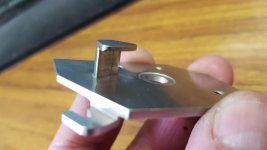maikol2346
Plastic
- Joined
- Jan 23, 2020
Hello,
I am attempting to cut a 5/8" slot on A36 steel using a woodruff cutter in a HAAS Mini Mill. As of right now the feedrate is about 3.4 in/min, however when the cutter goes in it sounds like an earthquake and quite frankly feels too aggressive. The cutter broke after the 5th part.
The RPM is about 530 and I'm using a #305 Woodruff KSC Shank HSS RH STAG from Keo Cutters, Inc. The cutter diameter itself is 5/8" by 3/32" width and it has 8 teeth.
How much slower should I go if slower at all? I have tried searching charts online and calculators but they all give me significantly higher numbers, and the cut already feels very aggressive.
P.S.: While doing the cut, the load on the cutter is about 20% and then spikes to ~40%. For the first few parts the cutter was fine but now it broke.
I am attempting to cut a 5/8" slot on A36 steel using a woodruff cutter in a HAAS Mini Mill. As of right now the feedrate is about 3.4 in/min, however when the cutter goes in it sounds like an earthquake and quite frankly feels too aggressive. The cutter broke after the 5th part.
The RPM is about 530 and I'm using a #305 Woodruff KSC Shank HSS RH STAG from Keo Cutters, Inc. The cutter diameter itself is 5/8" by 3/32" width and it has 8 teeth.
How much slower should I go if slower at all? I have tried searching charts online and calculators but they all give me significantly higher numbers, and the cut already feels very aggressive.
P.S.: While doing the cut, the load on the cutter is about 20% and then spikes to ~40%. For the first few parts the cutter was fine but now it broke.





